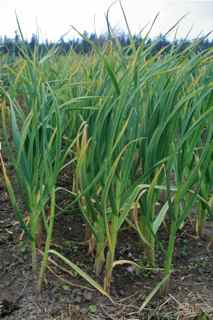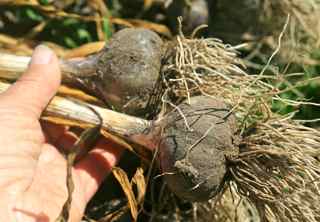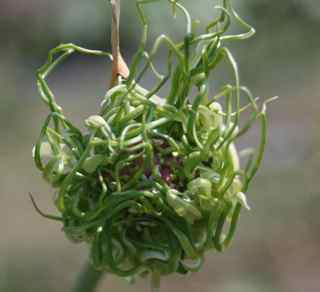Alternate Title: 7 Things You Can Do With Garlic Bulbils!
BULBILS. The word rolls around the tongue like a mouthful of marbles. They are the exotic blooms at the end of the scapes of hardneck garlic varieties that produce little seedlets.
 Bulbils, though, are a thing of their own. They are not a true flower. And all those little seedlets inside, which can be anywhere from the size of a grain of rice to a chickpea, are not true seeds. They are actually miniature cloves, clones of the parent plant. Some bulbils might have over 100 of them; others only half a dozen. And the beauty is that each has the potential to grow into a full-size garlic bulb, although it might take a couple of years to get there. They are something you can easily stash here, there, and everywhere in the garden (after all, one can never have too much garlic!), so if you think you’ve run out of room to plant more garlic, think again. Of course, if you follow conventional wisdom to cut your scapes, you might not have the chance to appreciate how unique they are.
Bulbils, though, are a thing of their own. They are not a true flower. And all those little seedlets inside, which can be anywhere from the size of a grain of rice to a chickpea, are not true seeds. They are actually miniature cloves, clones of the parent plant. Some bulbils might have over 100 of them; others only half a dozen. And the beauty is that each has the potential to grow into a full-size garlic bulb, although it might take a couple of years to get there. They are something you can easily stash here, there, and everywhere in the garden (after all, one can never have too much garlic!), so if you think you’ve run out of room to plant more garlic, think again. Of course, if you follow conventional wisdom to cut your scapes, you might not have the chance to appreciate how unique they are.
I have a new respect for bulbils. Last year, when I suspected mold beneath the soil, I let them grow. “If all else fails,” I thought, “at least I’ll be able to save some of my stock.” It was good thinking. The bulbils never touch soil.



So I tried a little experiment with them last year and planted them in flower pots and tubs, mainly because I thought surely they would get lost in my grassy patch I try to call a garden – which would have been true. I cannot say my experiment was a success, however. I had the tubs up against a fence at the far side of the property, not close by where I would see them, and when tragedy hit our family late last April, I pretty much up and left and forgot all about them. They never got watered, the grass grew up around them, my husband later weed-whacked the heck out of everything (“It didn’t look like anything was in there,” he said, which was true), and they pretty much shriveled up and died. Or so I thought.
Would you believe – there are some sprouts coming out of the tubs again! Amazing! They (or at least some of them) are still alive! Garlic is tougher than you’d think.
I didn’t plant them all in tubs, though. My Juan de Fuca Wonder bulbils, a Rocambole variety, produce rather large seedlets, which I stuck in neat rows at the end of one of my regular garlic beds. This proved to be much more successful. I didn’t plant them very deep (they are small, after all), nor very far apart, so 150 of them took up very little space. To be honest, I wasn’t expecting much – maybe some “rounds” (i.e., without clove definition) the first year that I would replant in the fall to produce full-size bulbs the following year.
Well, talk about prolific! These bulbils were the biggest surprise of my entire garlic harvest! I wish I had spaced them further apart. Many of them were over 2” in diameter – as large as many of the bulbs of my main crop of Juan de Fuca Wonders. They even formed scapes and cloves of their very own. I was so proud of them!
Seedlets that start out as rice-grain size will take an extra season or two to get up there – but I have to say, I am impressed with the Juan de Fuca Wonder’s ability to jump right up with the best of them.
The nice thing about planting bulbils is that not only is it the absolutely least expensive way to increase your crop, but there are so many things you can do with them.
For starters:
- Plant them now in your regular beds; thin them like baby onions; harvest in the spring like scallions. It’s that time of year when most garlic bulbs are past their prime and the fresh, delicate taste of garlic is SUCH a treat!
- Do as #1 above, but give them more time in the soil, harvest them in the summer and replant in the fall for bigger bulbs the following year. Plant large ones 2-4” apart; plant smaller ones like radishes.
- Do as #2 above, but don’t replant them. Eat them. (You know you want to.)
- Plant them in flower pots outside your door where you can keep an eye on them and then do #2 or #3 or both.
- Plant them in flower pots and grow inside on a kitchen windowsill. Clip the “grass” throughout the winter & use fresh like chives.
- Plant them in the spring – not fall – and clip like chives, grow & harvest like scallions, harvest in summer and replant in fall, or harvest in summer and consume in great quantities. In other words, do any or all of the above.
- Don’t plant them. Just eat them. Pickle them. Throw them in stir-fries, sauces, dressings. Cooked or raw, it’s all good (BTW – on some, the skins might be a little fibrous and a little tedious to peel – eat them anyway – fiber is good for you).
So – How many seedlets in a bulbil? On average, here is what I have counted:
Porcelains:
German Extra Hardy: 193 seedlets (9 grams)
Rosewood: 175 seedlets (7 grams)
Purple Stripes:
Brown Tempest: 130 seedlets (6 grams)
Metechi: 112 seedlets (8 grams)
Persian Star: 100 seedlets (2.5 grams)
Russian Giant Purple Stripe: 165 seedlets (12 grams)
Siberian: 80 seedlets (10 grams)
Rocamboles:
Juan de Fuca Wonder: 9 seedlets, (7 grams)
Killarney Red: 8 seedlets (12 grams)
Ready to give scapes a try? Check out our Garlic Page for updated availability and price – and then Contact me and let me know what you’d like. (Cool gift idea, too, is it not?)
Thanks! And Happy Planting!
****
(P.S. Thank you for your patience while I’m still trying to figure out this shopping cart system. At this point, the easiest way to order is to either send me an email through the Contact page, or if you’re in the neighborhood, stop by!)

I played bulbs of a tasty garlic .
Only to find roots after 4 months +_
Long tasty roots but no bulbs.
Watered nearly daily , soil good in plastic pots .Whats wrong ?
Hi Joel – Hmmm, I might be misunderstanding, but were you planting bulbils from the scapes? If so, it is common for them to take 2 or 3 years to size up. Just stick them back in the ground.
If, however, you were growing from the cloves of a large bulb of garlic, it sounds like your garlic wasn’t in the ground long enough.
I usually plant in late October here in the Pacific Northwest and harvest in July or August, which is about 9 months for those babies. Garlic requires a period of cold to develop bulbs.
Not sure where you are, when you planted, or what were your varieties, but there are a lot of variables that can affect garlic bulb success. Here is an article I wrote a few years ago that might be helpful: 25 Garlic Growing Management Strategies for Preventing Problems and Growing the Best Garlic Ever.
A lot of people plant anytime between early September and late November, so the timing is perfect to get next year’s crop started. Good luck!
Juan de Fuca Wonder’s is the one you talked about, sounds good to me. I just want to try some in pots as I am housebound and can fool with them on my inside porch and some on my outside deck. Do you put drain holes in the pots you made out of plastic?
You got it, Harvey – you should have them by now. Bulbils are absolutely perfect for armchair & back porch gardeners – and just so handy to have on a windowsill. I hope to plant some more tomorrow and give little pots as Christmas gifts a month from now.
In answer to your question, Yes, I drilled holes in the plastic tubs I used for planting bulbils in previously. Plus, because the tubs were rather tall, I cut a few inches off the top. I am sure you could use something much smaller – I just had some old tubs lying around and it was a good way to recycle them. Whatever you use, good drainage is important. Too much water and they can rot (as mine did last year after all the heavy rain & cold spring weather we had). Most sources will tell you they need constant moisture, but I have not found that to be the case. I kind of think of it like radishes or raspberries – lots of water, you might get bigger bulbs or fruit, but they won’t be as flavorful. Not that you want to stress the plants – you just want to try to walk that balance. Good drainage will help in that regard. I find it’s a little more critical to stay on top of the water when you grow things in pots. In the open ground, they seem to be able to find their own way a little easier if they aren’t strangled by weeds in the process!
Best of luck to you!